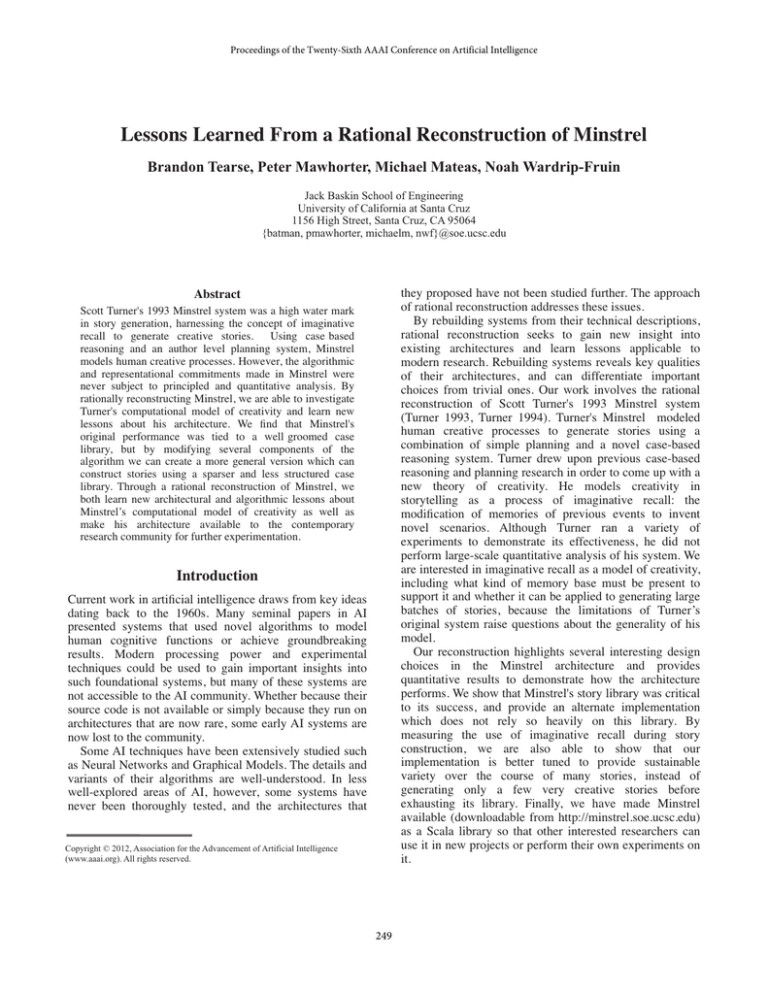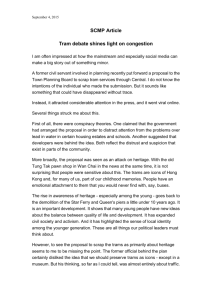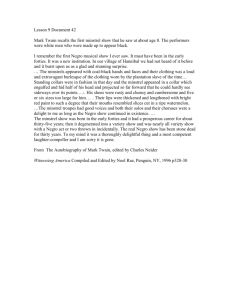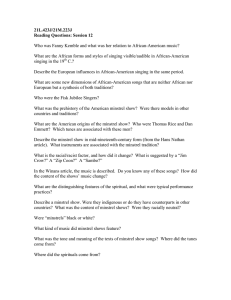
Proceedings of the Twenty-Sixth AAAI Conference on Artificial Intelligence
Lessons Learned From a Rational Reconstruction of Minstrel
Brandon Tearse, Peter Mawhorter, Michael Mateas, Noah Wardrip-Fruin
Jack Baskin School of Engineering
University of California at Santa Cruz
1156 High Street, Santa Cruz, CA 95064
{batman, pmawhorter, michaelm, nwf}@soe.ucsc.edu
they proposed have not been studied further. The approach
of rational reconstruction addresses these issues.
By rebuilding systems from their technical descriptions,
rational reconstruction seeks to gain new insight into
existing architectures and learn lessons applicable to
modern research. Rebuilding systems reveals key qualities
of their architectures, and can differentiate important
choices from trivial ones. Our work involves the rational
reconstruction of Scott Turner's 1993 Minstrel system
(Turner 1993, Turner 1994). Turner's Minstrel modeled
human creative processes to generate stories using a
combination of simple planning and a novel case-based
reasoning system. Turner drew upon previous case-based
reasoning and planning research in order to come up with a
new theory of creativity. He models creativity in
storytelling as a process of imaginative recall: the
modification of memories of previous events to invent
novel scenarios. Although Turner ran a variety of
experiments to demonstrate its effectiveness, he did not
perform large-scale quantitative analysis of his system. We
are interested in imaginative recall as a model of creativity,
including what kind of memory base must be present to
support it and whether it can be applied to generating large
batches of stories, because the limitations of Turner’s
original system raise questions about the generality of his
model.
Our reconstruction highlights several interesting design
choices in the Minstrel architecture and provides
quantitative results to demonstrate how the architecture
performs. We show that Minstrel's story library was critical
to its success, and provide an alternate implementation
which does not rely so heavily on this library. By
measuring the use of imaginative recall during story
construction, we are also able to show that our
implementation is better tuned to provide sustainable
variety over the course of many stories, instead of
generating only a few very creative stories before
exhausting its library. Finally, we have made Minstrel
available (downloadable from http://minstrel.soe.ucsc.edu)
as a Scala library so that other interested researchers can
use it in new projects or perform their own experiments on
it.
Abstract
Scott Turner's 1993 Minstrel system was a high water mark
in story generation, harnessing the concept of imaginative
recall to generate creative stories. Using case based
reasoning and an author level planning system, Minstrel
models human creative processes. However, the algorithmic
and representational commitments made in Minstrel were
never subject to principled and quantitative analysis. By
rationally reconstructing Minstrel, we are able to investigate
Turner's computational model of creativity and learn new
lessons about his architecture. We find that Minstrel's
original performance was tied to a well groomed case
library, but by modifying several components of the
algorithm we can create a more general version which can
construct stories using a sparser and less structured case
library. Through a rational reconstruction of Minstrel, we
both learn new architectural and algorithmic lessons about
Minstrel’s computational model of creativity as well as
make his architecture available to the contemporary
research community for further experimentation.
Introduction
Current work in artificial intelligence draws from key ideas
dating back to the 1960s. Many seminal papers in AI
presented systems that used novel algorithms to model
human cognitive functions or achieve groundbreaking
results. Modern processing power and experimental
techniques could be used to gain important insights into
such foundational systems, but many of these systems are
not accessible to the AI community. Whether because their
source code is not available or simply because they run on
architectures that are now rare, some early AI systems are
now lost to the community.
Some AI techniques have been extensively studied such
as Neural Networks and Graphical Models. The details and
variants of their algorithms are well-understood. In less
well-explored areas of AI, however, some systems have
never been thoroughly tested, and the architectures that
Copyright © 2012, Association for the Advancement of Artificial Intelligence
(www.aaai.org). All rights reserved.
249
and Daydreamer (Meuller 1990) systems. Since his work,
Margaret Boden (1996, 2004) and Graeme Ritchie (2001,
2007) have proposed models for creativity and methods for
measuring it. Boden focuses on the distinctions between
transformational, combinational, and exploratory creativity
(Minstrel focuses on the last of these). Boden also
describes the difference between P-Creativity (creativity
relative to a creator’s knowledge, which Minstrel exhibits)
and H-Creativity (creativity relative to a culture). Ritchie
builds on Boden’s ideas and focuses on novelty and quality
of artifacts as the most important measurable
manifestations of creativity.
Perhaps most directly relevant to our work is that done
by Kolodner (1994) on how standard CBR should be
altered in order to generate creative solutions. Although
Kolodner’s ideas are slightly different from Turner’s, they
offer an alternative and quite similar perspective to the
concept of using case transformation to support creativity.
Although we don’t focus on analyzing Minstrel Remixed
in terms of its creativity in this paper, these developments
in creativity theory have informed our reconstruction. In
particular, there is a close relationship between the TRAM
system in Minstrel and both the variety and quality of
results.
Related Work
Story and Planning and Case-Based Reasoning
Classic Minstrel and its Remix are similar to a number of
other systems for story generation. Some of the earliest
work in this area was done by systems that relied primarily
on planning algorithms such as Universe (Lebowitz 1954)
and Talespin (Meehan 1977). Later storytelling systems
such as Fairclough’s multiplayer story generator and
Gervas et al.’s plot generator have demonstrated the
effectiveness of CBR techniques applied to the problem of
story generation (Fairclough and Cunningham 2003,
Gervas et al. 2005). One of the difficulties in applying
Case-Based Reasoning (CBR) to stories is coming up with
a searchable and compositional representation of story
events. Fairclough and Gervas et al. drew extensively from
Vladimir Propp’s formal theories about the substance of
Russian folktales (Propp 1968) to come up with
representations of stories that were amenable to being
searched as a case base (Turner was aware of Propp’s
analysis, but developed his own method of representing
stories involving a graph of frames describing story
events.)
Minstrel is related to all of these systems since it uses
both planning and CBR. A modified form of Case-Based
Planning which involves incremental transformation and
adaption steps is employed for fine grained generation
while planning is used to simulate higher level authorial
intention and additions that an author might use while
creating a story.
Architecture
Our system, called Minstrel Remixed (MR), is a rational
reconstruction of Scott Turner’s 1993 Minstrel system.
Working from Turner’s dissertation describing the system,
we have re-implemented the core algorithms and
supporting structures in Scala (Turner, 1993). MR includes
the original components of Minstrel as well as a few
upgrades of our own devising. Additionally, MR is easily
configurable, and it includes a configuration designed to
imitate the original Minstrel as closely as possible.
Rational Reconstruction
Rational reconstruction (RR) is the process of
reconstructing existing systems with the goal of
understanding their operation as well as the original design
decisions involved, and how those decisions affected the
final system. Rational reconstruction efforts offer a chance
to critically reexamine older research, as well as to explore
fruitful designs using modern tools. There are a number of
books which discuss RR as a useful tool such as Partridge's
books on the fundamentals of Artificial Intelligence
(Partridge 1990, Partridge 1991). Additionally, a number of
papers discuss successful rational reconstruction projects
such as Langley's rebuilding of the GRIDS system
(Langley and Stromsten 1990), Ritchie's reconstruction of
Proteus (Ritchie 1984), McDonald's reconstruction of
Genaro (McDonald 1999), and even Peinado and Gervas'
reconstruction of Minstrel's ontology using the OWL Web
Ontology Language (Peinado and Gervas 2006). These
works demonstrate rational reconstruction’s potential for
producing knowledge about existing systems and
informing new theories.
The Minstrel Architecture
Minstrel is a complex architecture including many
subsystems and components. In this paper we focus on
three subsystems which are relevant to how imaginative
recall interacts with the story library: TRAMs, ALPs, and
boredom. TRAM stands for Transform Recall Adapt
Method and ‘the TRAM system’ refers to a collection of
TRAMs and accompanying support mechanisms that are
used to generate the fine details of a story. ALP stands for
Author Level Plan and these are used to direct the broader
themes of a story as well as being used to enforce a variety
of consistency constraints. Together the planning of the
ALP system and the modified case-based reasoning of the
TRAM system allow for complete stories to be pieced
together. The third relevant system, boredom, helps to
ensure that stories that are generated differ both from the
stories in the library and from subsequently produced
stories.
Computational Creativity
Turner’s work on Minstrel built on an existing literature in
computational creativity, including the AM (Lenat 1976)
250
new query retrieves a fragment from the case library about
Bob fighting a troll with a magic sword. This result is
finally adapted back to a fragment in which Bob fights the
dragon with a magic sword, satisfying all of the original
requirements.
TRAMs operate inside of a backtracking search tree,
allowing for many different sets of TRAMs to be tried in
order to eventually find a match for a given query. Figure 2
below illustrates a TRAM search tree with 3 useable
TRAMs. The query passed in is the top node in which a
knight fights something. Three TRAMs are possible
children of this node and in the diagram, the middle child
has been picked, transforming the query to a person
fighting something. At this point Minstrel might recall, a
peasant fighting a troll. When adapted back, a story about a
knight fighting a troll makes sense. If the recall were to fail
however (if there are no stories in the library about people
fighting) there are 2 children, relaxing the constraint that
there is a person involved (which would likely result in
adequate results) or releasing the constraint of a fight being
in the matching story. Now Minstrel might match a story
about a princess eating a berry, yielding a much stranger
story after adaptation: a knight fighting a berry.
TRAMs
TRAMs (Transform Recall Adapt Methods) support a
modified form of case based reasoning. In Minstrel, many
small fragments of stories are created over the course of
creating a whole story and this is done by the TRAMs. The
TRAM system is called with a search query which is
generally a partially defined story fragment such as
“someone does something to a dragon which kills it.” The
system has a number of TRAMs which can be recursively
applied in any order to a given query to find a match: each
TRAM applies changes (Transforms) the query (usually
making it more general) until a match is found (Recall),
and then each TRAM Adapts the result, so that at the end
of the process the modified result applies to the original
query. So the TRAMs both control the search direction and
handle the adaptation step in Minstrel’s case-based
reasoning subsystem.
The first step for each query is to attempt to recall
fragments out of the story library which match without any
transformation. Failing this, TRAMs have transformations
that they apply to the query before recursing. Effectively,
the TRAM system searches through a space of TRAM
applications to find a linear sequence of TRAMs which
lead to a query that directly matches a story fragment in the
library. When a result is found, each TRAM in the
recursive stack applies its own adaptation code,
transforming the result into a form applicable to the
original query. The benefit of this method is that it can use
precise transformations and adaptions in sequence to
effectively find cases that are quite different from the
original query. Of course, the TRAMs are not perfect, and
the more TRAMs used, the higher the risk of a result which
is incoherent with the rest of the story. Thus the TRAM
system relies on a story library which contains examples
that are fairly close to the queries it attempts to answer.
Knight
fights ?
Knight
?s ?
Person
fights ?
Person
?s ?
?
fights ?
?
?s ?
Figure 2. TRAM search space
Figure 2 includes two first level children which are
instances of the same TRAM: Generalize Constraint
(which turns a constraint into a ‘?’). The original Minstrel
only considers each TRAM once, choosing a target for its
modification. Classic Minstrel makes these decisions
randomly, which can cause it to overlook possible results.
We made two significant changes to TRAM search in
Minstrel Remixed to support deterministic searches while
maintaining the core functionality. First, we split each node
of the search tree into fragments which include targeting
information as well as a given TRAM. This allows the
system to explore all of the possible applications of each
TRAM, but also greatly expands the search space. To
compensate for this expansion, we added a strict limit to
the number of nodes the system was allowed to explore. In
addition to Turner’s limit of a search depth of 3 TRAMs,
we forced the system to stop searching for a result after
exploring 250 nodes in the TRAM search tree. We also
modified the TRAM selection algorithm to treat variants of
Figure 1. TRAM system in action
In Figure 1, an example query is shown in which Bob
needs to do something to a dragon but no stories are
available in the library which can be used. As a result, a
TRAM converts the dragon to a generic monster and this
251
a single TRAM with different targeting information as a
single TRAM for the purposes of selection during search,
to ensure that our addition of variants didn’t bias the search
process.
Our second modification was the addition of a weighted
random selection method to control the search. In our
modified version, each TRAM is assigned a weight,
corresponding roughly to how much it modifies the
original query. TRAMs are then selected randomly with
probability inversely proportional to their weights, so that
TRAMs which have more drastic effects are chosen less
frequently. The overall effect of this modification is to keep
stories from being too strange even when multiple TRAMs
are required to get a result by searching more intensely in
the part of the search space closest to the original query (in
terms of the strength rather than the number of TRAMs).
The cost is that the most creative solutions are more rare,
because dramatic modifications to a query are one (risky)
way to achieve creative results. To compensate for this, we
generate more stories. Turner’s original system can
generate five quite creative stories before beginning to
generate incoherent stories (a limitation that Turner
discussed in his own dissertation, as we note below in the
context of the Boredom subsystem.) Instead, we want to
produce a system that can generate hundreds of different
stories, most of which will contain some creativity and
some of which will be highly creative.
it entirely if this would put it below a minimum priority
threshold. This convention allows goals to interact: if one
goal cannot be solved initially, other goals are attempted in
the hopes that they will alter the story configuration and
make the initial goal solvable. Once the goal queue is
empty, story generation is finished.
In the original Minstrel, the goal queue contained lowpriority goals (which would be executed last) for
generating prose from the story graph that Minstrel had
produced. Because Minstrel Remixed does not yet have a
natural language generation component, our system’s
output is currently raw story graphs. Although these aren’t
accessible to a wide audience, we are able to interpret them
and judge the variety and consistency of the stories that
they represent in order to learn about Turner’s algorithm.
Boredom
Boredom is the final relevant subsystem to our current
discussion. To add variability to the system, Minstrel is
programmed to get bored with similar repeated solutions to
the same problems and, as a result, to find novel untried
solutions. This is implemented as a table of query/solution
signatures coupled with a boredom value. Every time a
query is given to the TRAM system and a solution
returned, the boredom value of that signature is
incremented. Minstrel won’t allow high boredom query/
solutions to be used, so as the boredom value for a pair
rises, other solutions must be found for given queries.
Without this method of enforcing variation, Minstrel would
sometimes generate duplicate stories (of course, the
random nature of the TRAM searches also contributes to
variation whenever TRAMs are used to generate results).
Classic Minstrel has a boredom threshold of two and
increments boredom values of signatures by one every time
a query/result pair is used. In section 15.7.2 of his
dissertation, Turner evaluates boredom by generating six
stories, showing how boredom drives the use of new
material, but also that by the sixth story, Minstrel has
exhausted its story library (Turner 1993). As a result,
Minstrel Remixed contains an upgraded boredom system
in which each call to the TRAM system fractionally
decrements the values of all signatures in the boredom
table. Functionally this means that signatures refresh over
time, allowing them to be reused in subsequent stories.
Using this system, instead of quickly becoming bored of
everything, Minstrel establishes a cyclical pattern of
boredom. This forces it to generate a variety of stories, just
like the original boredom heuristic, and the random nature
of the TRAM system means that the set of boring results
doesn't have any predictable pattern. The effect is similar
to generating each new story using a random subset of the
story library, always avoiding recent results. This
randomization produces much more sustainable variety
than Turner's original boredom mechanism: it distributes
the creative potential of the system given the story library
more evenly over a large number of stories.
Author-Level Planning
In the author-level planning system, Minstrel pursues
author-level goals (ALGs) by retrieving and executing
author-level plans (ALPs) that serve specific functions in
the service of generating a story. High level goals consider
the story as a whole, and represent tasks such as deciding
on a theme for the story or checking the story for
opportunities to insert foreshadowing. At the same time,
lower level goals concern things such as filling out the
details of a particular state or act within the story, or
checking that a particular story node is consistent and
properly motivated. Some of the ALPs encode microtheories about storytelling (theories of consistent
motivation, for example) that help Minstrel produce
consistent output. Other ALPs rely on the story library to
act as a model of a well-formed story, using the TRAM
system to fill in pieces of the story under construction with
appropriate material.
It is worth noting that Minstrel does not simply generate
free-form story structures. Instead, it relies on a “planning
advice theme” (PAT, or more generally a story template) to
give structure to its stories. These story templates contain
rough specifications for important parts of the plot.
Minstrel generates stories by selecting an appropriate PAT
and then filling in the details of the PAT, adding extra
scenes to the story as necessary along the way.
Once a goal is selected and a set of plans to achieve that
goal is found, plans are tried one by one until one
succeeds. If all available plans fail, the system re-enqueues
the current goal with half of its original priority and drops
252
version. Due to slight differences in our architecture and
information lacking in Turner's dissertation (such as the
exact contents of the story library) we were not able to
perfectly duplicate the original. However, we did recreate
the original boredom system and TRAM search method,
which are the only components varied between our two
experimental conditions.
Experiments
Although Minstrel's original configuration works well for
building stories, it does this by virtue of access to a welltailored story library: in section 15.10 of his dissertation,
Turner reports that 88% of searches in his system were able
to recall episodes directly from the story library without
using imaginative recall (Turner 1993). The original
system was also designed to generate only a few stories at
a time, especially given the aggressive boredom
mechanism (discard a result forever if it's been used twice).
These facts raise questions about imaginative recall as a
model of creativity: can imaginative recall function
effectively in an environment where direct recall is not the
norm, and can imaginative recall be tuned to focus on
producing variety with occasional creativity, rather than
making everything creative but quickly running out of
episodes to recall? To the extent that Turner's system relies
heavily on an extensive library and can generate only a few
stories at a time, it is not an effective model of human
creativity, because humans have no such limitations. On
the other hand, if these properties were simply outgrowths
of architectural choices that could have been made
differently, Turner's claim that imaginative recall is a
model of human creativity might still be valid. To explore
these issues, we focused on changes that allow the system
to work with a sparser library and to produce substantially
more stories by distributing its creativity more evenly. We
validated these changes by showing that during
imaginative recall, our modified system is more successful
than Turner's system overall, and that, for successful
searches, it searches a smaller space and finds results using
fewer transformations than Turner's system. This implies
that the underlying model of creativity as imaginative
recall is not inherently limited in terms of requiring an
extensive library or quickly exhausting creative results.
One reason that Turner focused on generating only a
small number of stories may have been the limited
computing power available to him in 1993. Given a
modern computer (2.4 GHz Intel i7 with 8 GB of RAM),
we can generate stories quite quickly (56 seconds per
story), and thus it is reasonable to expect a system to
generate tens or hundreds of stories at a time. Turner's
original system took an average of 1,400 seconds to
construct a story, so such mass production was not quite as
feasible (even though his version was probably better
optimized, considering that our average is only two orders
of magnitude faster). His approach also corresponds to a
different application of creativity: if a person were to
produce one creative story twenty times in a row, she
would produce a different result than if you ask her for
twenty creative stories. Turner's original model is closer to
the first case, while our changes have made the system
operate a bit more like the second case (although explicit
planning for distributing creative results across multiple
stories remains a direction for future work).
To test our modifications, we set up a version of our
system that duplicated the performance of the original as
closely as possible, and compared it to our modified
Method
Our tests involved generating stories and measuring the
performance of the TRAM system. Because the TRAM
system is the main mechanism for creativity, the number of
TRAMs used and the number of TRAMs tried reveal
information about the functionality of the system. For our
reconstruction of Turner's original system, we generated 75
stories using random TRAM selection and eliminative
boredom. We then restarted the system (to reset boredom)
and asked it to generate 75 new stories, this time with
weighted TRAM selection and boredom reduction enabled.
For each batch of stories, we recorded every call to the
TRAM system, including whether it succeeded, how many
TRAMs it tried while searching for a result, and how many
TRAMs were used to find the result if it succeeded (note
that the number of TRAMs used is never more than three
(the depth limit) but that the number of TRAMs tried may
be much larger). For both experiments, we used Turner's
original depth limit of three TRAMs, as well as our
exploration limit of 250 TRAMs. We used a single story
template (PAT) for all 150 stories, which helps exercise the
boredom mechanism (Turner's original boredom
experiment also used a single PAT). Our story template
consists of one character trying to kill another character but
accidentally dying, after which a third character avenges
the first character.
Results
Given our recreation of the original system, we found that
for successful queries that involved TRAMs (as opposed to
queries that found a result directly) an average of 2.38
TRAMs were used. In contrast, our modified system used
an average of 1.39 TRAMs when it used TRAMs to find a
result.
In the recreated version, out of 490 total TRAM
attempts, 59% of searches found a result directly, 22.2%
used one or more TRAMs, and 18.7% failed (as a result of
running into the exploration limit). In our modified version,
which made 503 total TRAM attempts, 72.2% of searches
found direct results, 24.5% used one or more TRAMs, and
3.4% failed. For searches that succeeded (including
searches that succeeded directly), the recreated system
tried an average of 13.8 TRAMs, while our version tried
7.7 TRAMs. When only searches that required TRAMs to
succeed are considered, the recreated system tried 141.3
TRAMs on average, while ours tried 56.8. These results
are summarized in table 1 below.
253
Most of the results are driven by our boredom changes:
with fewer results excluded via boredom, it's easier to find
valid results (including direct results). This means that
fewer TRAMs are needed, fewer TRAMs need be
attempted, and fewer queries fail. Overall, this leads to the
conclusion that Turner's original design was tuned to
generate only a small number of stories, which makes
sense given the experiments that he chose to conduct. It's
also apparent that our story library is not as well tuned as
Turner's was. He reported that 88% of searches found
results directly, whereas using his parameters, only about
59% of ours do. Even using our new parameters
(particularly our more lenient boredom mechanism) only
about 72% of searches succeeded directly. With his original
library, direct recall of queries was the norm, while our
library is considerably less exhaustive. Although spending
time tuning our library might increase the number of direct
results, it's not a good way to leverage the architecture.
Effectively, tuning the story library represents increasing
the quality of stories by hand-authoring more content, and
this tuning must be done separately for each domain to
which the architecture is applied.
Instead, we have made the core algorithm more robust:
our modifications reduce the percentage of failed TRAM
searches from 18.7% to just 3.4%, even given the less
dependable story library (relative to Turner's). Of course, a
single failed TRAM search does not mean that the relevant
story failed to generate: the search will be tried again later
by Minstrel's author-level planning system, and might
succeed, or information for that node might be filled in by
other searches. TRAM failures do represent lost
opportunities to find creative results, of course, and they
could cause story generation to fail entirely if they occur
too frequently.
Results that are found by applying more TRAMs are
generally more creative (but also more likely to be
incoherent). This is because the changes to the query made
by each TRAM decrease the amount of context used in the
search. Turner reported that after just five stories, the
boredom assessment was causing TRAMs to find
questionable results. The modified TRAM and boredom
system, by performing fewer TRAM applications on
average, reins in this creativity, meaning that many of our
results are minor modifications of content in the library.
When it uses TRAMs to find a result, our system only
explores 56.8 TRAM combinations on average, and the
results that it finds use an average of 1.4 TRAM
applications. In contrast, the reconstructed system explores
an average of 141.3 TRAM combinations and uses an
average of 2.38 TRAMs. Compared to our version,
Turner's version requires more effort to find results, and
when it finds them, they are less similar to the original
query. These numbers only include searches that used
TRAMs successfully, so they are independent from the
difference in failure rates. Of course, when generating a
large batch of stories, creative results will be mixed in
either due to luck or due to our modified boredom
mechanism. Rather than quickly exhausting Minstrel's
creativity, we have chosen to mete it out more sparingly
across many stories, so that our system can effectively
generate a wide variety of simple variations, with some
especially creative variations mixed in.
Total Searches
Direct Matches
Indirect Matches
Failures
Avg. TRAMs tried
Avg. TRAMs tried
(all matches)
Avg. TRAMs tried
(indirect matches)
Avg. TRAMs used
(all matches)
Avg. TRAMs used
(indirect matches)
Turner’s Version Recreated Version
490
503
289 (59%)
109 (22.2%)
92 (18.7%)
363 (72.2%)
123 (24.5%)
17 (3.4%)
57.9
13.8
15.8
7.7
141.3
56.8
0.65
0.35
2.38
1.39
Table 1: Experimental results from the generation of 25 stories.
Conclusion
Rational reconstruction aims to rebuild existing systems
from their technical specifications in order to learn more
about the motivations behind architectural decisions as
well as figure out which parts of a system are essential to
its operation. In our rational reconstruction of Minstrel, we
have also tried to create a system that makes the Minstrel
architecture available in a modern format and which adapts
the architecture to exploit the increases in computing
power since Minstrel's first release. Instead of focusing on
generating a few very creative stories, our system focuses
on longer-term generation of story variants, some of which
we expect to be creative. Our system is also less reliant on
a finely-tuned story library than Turner's. It is able to
function with only a 3% search failure rate even with only
a 72% direct match rate against our story library. Our
reconstruction of Turner's system, in contrast, matches
against the story library only 59% of the time and fails
22% of the time. By modifying the boredom heuristic we
are able to achieve dramatically increased success rates,
and by also modifying the TRAM search method, we have
created a system tuned for producing large batches of
results that contain some creativity. These successes show
that Turner’s model of creativity as imaginative recall is
more flexible than the system that he built to demonstrate
it.
As we reconstructed Minstrel, it seemed at first to be
extremely specific. Because Turner's original story library
isn't available (it isn't fully described in his dissertation) we
constructed our own story library, but quickly found that it
didn't match our templates closely enough. If extensive
library tuning were required for Minstrel to function, it
254
would not be a model of strong creativity, because its
creative power would depend on a high rate of
unimaginative recall rather than extensively using
imaginative recall. Although Turner claims that his system
demonstrates that creative recall is not necessarily common
when making up stories, it is more useful to have a system
which can operate using more or less imagination
depending on the situation: such a system can then be
compared to human performance in a variety of situations.
Thus instead of tuning our library to produce results, we
focused on modifications to the original that could allow it
to work with a sparser library, while still retaining creative
results. As our experiment demonstrates, we have created a
version of the Minstrel architecture that works well for
generating large batches of stories, even with a less tailored
library.
Through our efforts, we not only gained knowledge
about the original system, but also created a new version
which is available in a modern format. This is an
encouraging result because it indicates that rational
reconstruction of older systems is a productive way to gain
new knowledge about AI architectures and to better
understand existing computational models of human
cognition. Using our reconstruction, it is now feasible to
concretely investigate imaginative recall as a model of
human creativity by comparing it directly to human results.
Langley, P., and Stromsten, S. 2000. Learning Context-Free
Grammars with a Simplicity Bias. In Proceedings of the
11th European Conference On Machine Learning, 220-228
Lebowitz, M. 1985. Story-telling as planning and learning.
Poetics, 14(6).
Lenat, D. 1976. AM: An Artificial Intelligence Approach to
Discovery. Ph.D. diss., Dept. of Computer Science,
Stanford University, Stanford, CA.
McDonald, D. 1999. A Rational Reconstruction of Genaro.
In Proceedings of the RAGS Workshop.
Meehan, J. 1977. Tale-spin, an interactive program that
writes stories. In Proceedings of the Fifth International
Joint Conference on Artificial Intelligence.
Mueller, E. 1990. Daydreaming in Humans and Machines:
A Computer Model of the Stream of Thought. Norwood,
NJ.: Ablex Publishing
Partridge, D. 1991. A New Guide To Artificial
Intelligence. Norwood, NJ.: Ablex Publishing
Partridge, D., Wilks, Y. eds. 1990. The Foundations of
Artificial Intelligence: A Sourcebook. New York, NY.:
Cambridge University Press.
Acknowledgments
Peinado, F., Gervas P. 2006. Minstrel reloaded: from the
magic of lisp to the formal semantics of OWL. In
Technologies for Interactive Digital Storytelling and
Entertainment, 93–97.
This material is based upon work supported by the
National Science Foundation under Grant Number
IIS-1048385. Any opinions, findings, and conclusions or
recommendations expressed in this material are those of
the authors and do not necessarily reflect the views of the
National Science Foundation.
Propp, V. 1968. Morphology of the Folktale, trans.
Laurence Scott. Austin, TX.:University of Texas Press.
Ritchie, G. 1984. A Rational Reconstruction of the Proteus
Sentence Planner. In Proceedings of the 10th international
conference on Computational linguistics.
References
Boden, M. ed. 1996. Dimensions of Creativity. Boston,
MA.: MIT Press
Boden, M. 2004. The Creative Mind: Myths and
Mechanisms.: London, UK.: Routledge
Ritchie, G. 2001. Assessing Creativity. In Proceedings of
the AISB ’01 Symposium on AI and Creativity in Arts and
Science, 3-11.
Fairclough, C., and Cunningham, P. 2003. A multiplayer
case based story engine. In 4th International Conference
on Intelligent Games and Simulation, 41–46.
Ritchie, G. 2007. Some Empirical Criteria for Attributing
Creativity to a Computer Program. In Minds and
Machines. 17(1). 67-99.
Gervas, P., Diaz-Agudo, B., and Hervas, R. 2005. Story
plot generation based on cbr. Journal of Knowledge Based
Systems, 235-242
Turner, S. 1993. MINSTREL: a computer model of
creativity and storytelling.
Turner, S. 1994. The creative process: a computer model of
storytelling and creativity.
Kolodner, J. 1994. Understanding Creativity: A CaseBased Approach. In Topics in Case Based Reasoning, 3-20.
Berlin: Springer Verlag.
255





